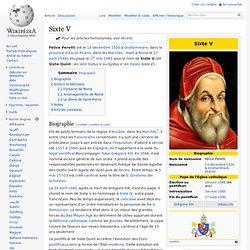

The Multiversal Age. By Amonakur Insight.

Just use your Pineal gland. You will find out by Yourself. Wisdom never comes from prejudice. Patanjali Yoga Aphorisms are a good starting point to make sense. In the faith of love act truly. There is no need to believe in nonsense. Please, take care !!! Like the first time. Amonakur Every day of your life, remember that harmonic cycles run the whole thing.Cymatics teach that no separate wish or desire could ever force a big bang to create whatsoever. This unfortunate non respectful thickness of the heart, interrupts the connection between living creatures that find themselves isolated in a never ending loop that ultimately takes these insensible people to vice.
Water teaches and remembers. 4 Meditations The Secret Source Forgiveness, Truthfulness, Control of the Mind, Purity, Practice of Charity, Control of the Senses, Non-Violence, Q. Dean Sloan. Sixte V. Un article de Wikipédia, l'encyclopédie libre.

Pour les articles homonymes, voir Peretti. Felice Peretti (né le à Grottammare, dans la province d'Ascoli Piceno, dans les Marches - mort à Rome le ), élu pape le 1er mai 1585 sous le nom de Sixte V (dit Sixte Quint ; en latin Sixtus V ou Systus V, en italien Sisto V). Biographie[modifier | modifier le code] Le , après la mort de Grégoire XIII, il est élu pape. Il choisit le nom de Sixte V en hommage à Sixte IV, autre pape franciscain. Blason de Sixte V Sixte V le bâtisseur[modifier | modifier le code] En 1586, Sixte V inaugure toute une série de travaux en grande pompe. Place Saint-Pierre : réérection de l'obélisque en 1586. Il ouvre un concours, choisit le plan de Domenico Fontana, ancien compagnon maçon, et s'y attache contre l'avis de tous avec d'autant plus de chaleur qu'on jugeait l'exécution de l'ouvrage impossible[2].
Religions du monde..! Kundalini Yoga - Theory. Chapter Two Yoga Nadis Nadis are the astral tubes made up of astral matter that carry psychic currents.

The Sanskrit term ‘Nadi’ comes from the root ‘Nad’ which means ‘motion’. It is through these Nadis (Sukshma, subtle passages), that the vital force or Pranic current moves or flows. Since they are made up of subtle matter they cannot be seen by the naked physical eyes and you cannot make any test-tube experiments in the physical plane. The body is filled with innumerable Nadis that cannot be counted.
Nadis play a vital part in this Yoga. The subtle lines, Yoga Nadis, have influence in the physical body. Whenever there is an interlacing of several nerves, arteries and veins, that centre is called “Plexus.” All the Nadis spring from the Kanda. Again Ida, Pingala and Sushumna are the most important of the above 14 Nadis, and Sushumna is the chief. Spinal Column Spinal Column is known as Meru Danda. "Kama Loka" by William Q. Judge. Monothéisme.
Athéisme et agnosticisme. AGNÔSTOS. Feu, soleil. Le rituel d'immolation par le feu. Eclairage sur le Zoroastrisme « Bakou Francophones. O Première religion monothéiste, le zoroastrisme puise ses origines dans les régions persiques (dont l’Azerbaïdjan faisait partie).

Le zoroastrisme est un culte encore pratiqué par environ 200,000 fidèles à travers le monde, principalement en Inde et en Iran. Dans la religion, Ahura Mazdâ (pehlevi Ohrmazd) est le dieu, seul responsable de la mise en ordre du chaos initial, le créateur du ciel et de la Terre. La religion trouve ses fondements au cours du Ier millénaire av. J. Zarathoustra père fondateur du zoroastrisme Nous savons que tout au long de l’histoire, les adeptes de la religion zoroastrienne se verront affublés de l’appellation aussi approximative que restrictive d’« adorateurs du feu », que cela soit en grec pursolatreia, en lat. ignicoles, en arménien moxrapašt3 « adorateurs de cendres », ou encore en persan moderne ātaš parast.
Les Parsis La place du feu dans le culte zoroastrien Comment maintient-on un feu ? L’ordalie par le feu Les tours du silence. Obscures cabbales. Archives_2.0. Formation des dogmes. Réfléchir. Philo et spiritualité.